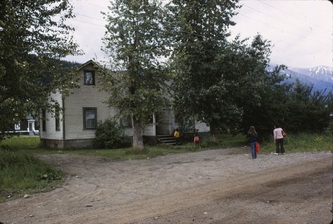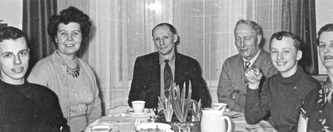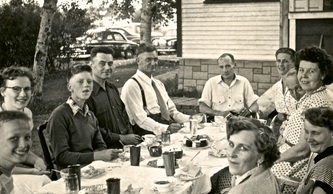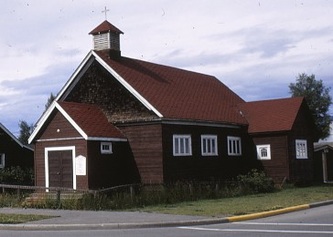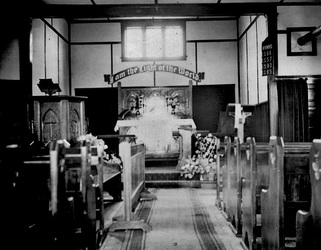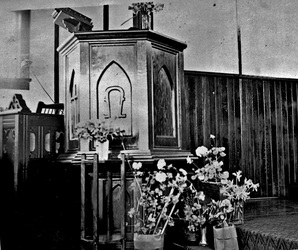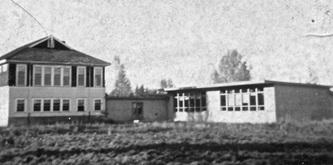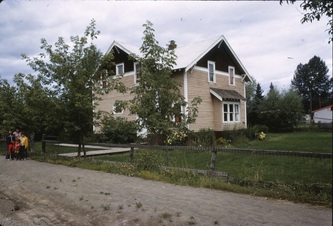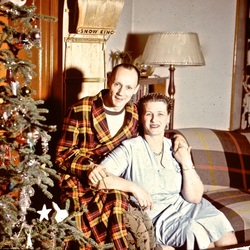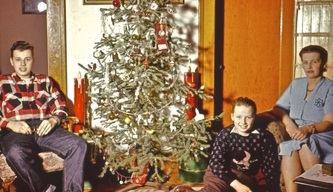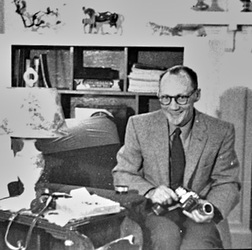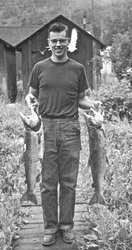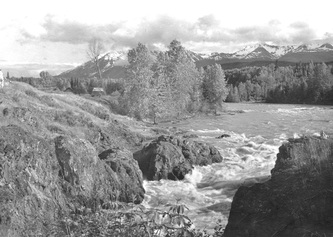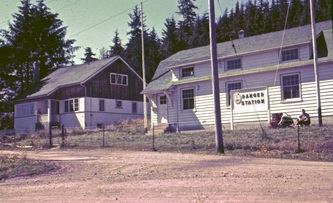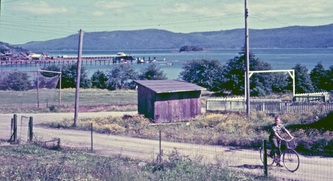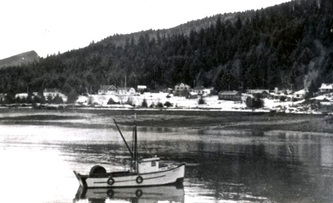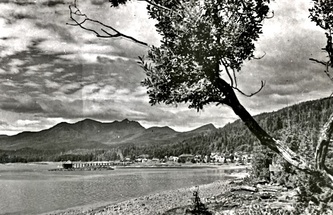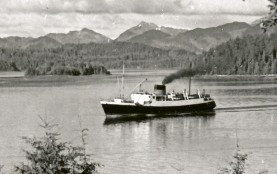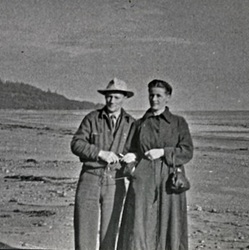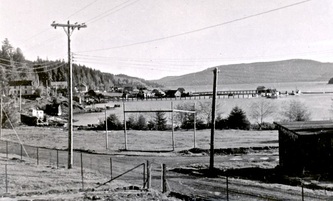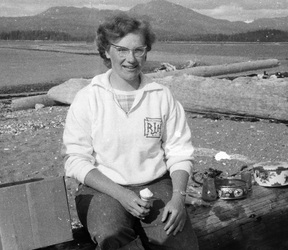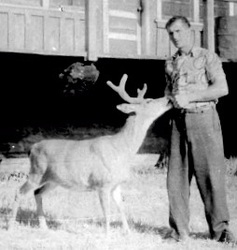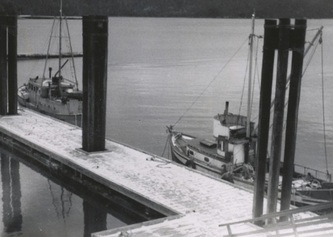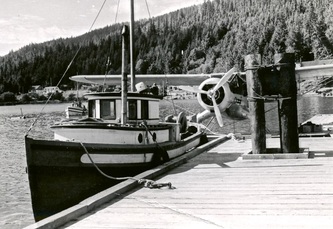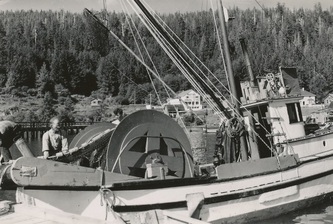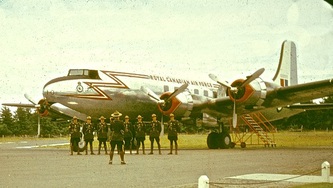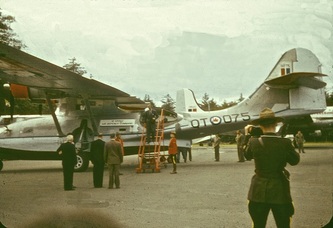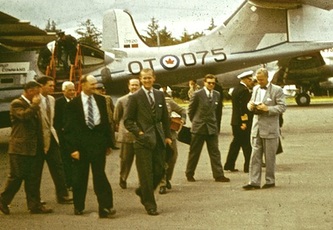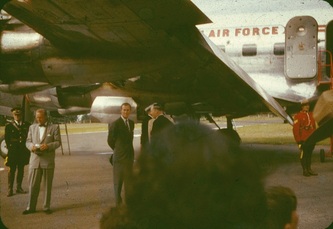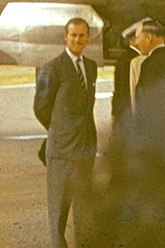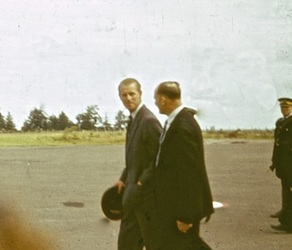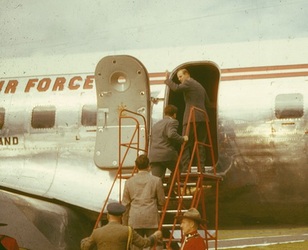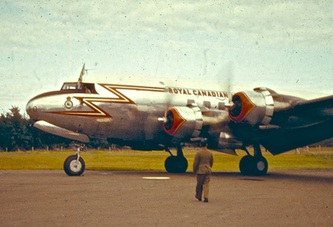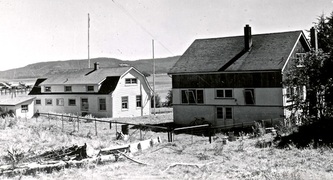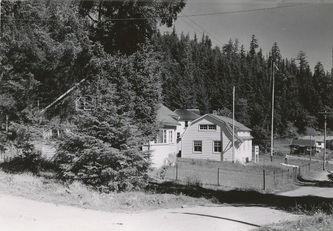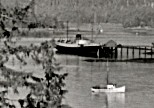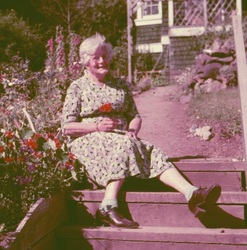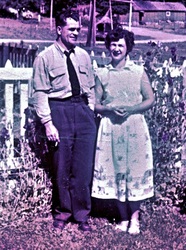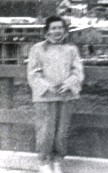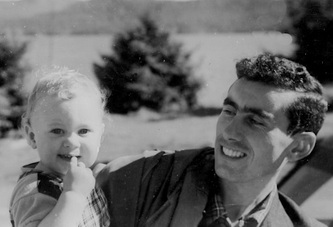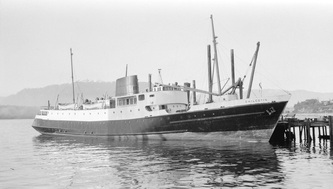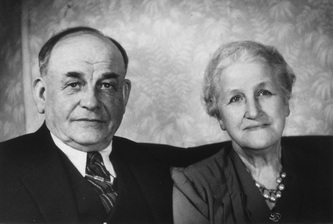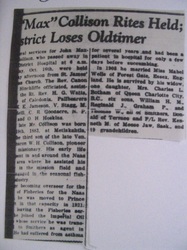The photos above: Left: Hudson's Bay Mountain from Lake Kathlyn showing the Glacier and Glacier Gulch below it.; Right: The bottom of Glacier Gulch showing the two streams draining the glacier - Nancy Leighton and Muriel made the hike.
Ten - Smithers & the Queen Charlotte Islands
1951 - The family moves to Smithers
After 15 years Charles found himself back in the Forestry office in Smithers. Much had happened in Smithers in the intervening time but as he quickly discovered many of the duties were much the same. Cruising timber, inspecting timber sales and burning requests, writing permits for various activities, and in general keeping track of the forest activities in the district hadn't changed.
It was October 19th when the family moved back to Smithers. Charles had found a house on Columbia and Alfred Streets, only a block from Railway Avenue, so we could hear the trains, especially at night. The owner was Tommy Goodwin and the price was $5,000.00, for which Charles paid in cash. It was a well-built house, but the kitchen-dining room was quite small, so they had Marion’s brother Reg, an experienced builder, build an extension on the back of it.
When they moved autumn was already well under way. Many of the leaves had fallen off the trees on their lot. It was time to rake, and Peter did that with enthusiasm.
Of course, the three kids were immediately registered in the local high school which was very different from what they were used to in Hazelton. Because it was in a larger town the classes were larger. Jim was eleven and went into a class of 35 grade sixes. Ann, 14 was in a Grade 9-10 split, while Peter, at the age of 15, went into an 11-12 split. In most cases there was a different teacher for each subject, which was a unique experience for us. But in this school we had real homework assignments which had to be done.
That winter was quite cold, but the new house was nice and warm. Life was fuller for the family, with their grand-parents, and other relatives in town. Charles took over the job as organist-choirmaster at St James’ Anglican Church from mother-in-law, Mabel, with Marion, Ann and Peter in the choir. Also in the choir were his parents-in-law Max and Mabel, and his brother-in-law Bill Collison.
Ten - Smithers & the Queen Charlotte Islands
1951 - The family moves to Smithers
After 15 years Charles found himself back in the Forestry office in Smithers. Much had happened in Smithers in the intervening time but as he quickly discovered many of the duties were much the same. Cruising timber, inspecting timber sales and burning requests, writing permits for various activities, and in general keeping track of the forest activities in the district hadn't changed.
It was October 19th when the family moved back to Smithers. Charles had found a house on Columbia and Alfred Streets, only a block from Railway Avenue, so we could hear the trains, especially at night. The owner was Tommy Goodwin and the price was $5,000.00, for which Charles paid in cash. It was a well-built house, but the kitchen-dining room was quite small, so they had Marion’s brother Reg, an experienced builder, build an extension on the back of it.
When they moved autumn was already well under way. Many of the leaves had fallen off the trees on their lot. It was time to rake, and Peter did that with enthusiasm.
Of course, the three kids were immediately registered in the local high school which was very different from what they were used to in Hazelton. Because it was in a larger town the classes were larger. Jim was eleven and went into a class of 35 grade sixes. Ann, 14 was in a Grade 9-10 split, while Peter, at the age of 15, went into an 11-12 split. In most cases there was a different teacher for each subject, which was a unique experience for us. But in this school we had real homework assignments which had to be done.
That winter was quite cold, but the new house was nice and warm. Life was fuller for the family, with their grand-parents, and other relatives in town. Charles took over the job as organist-choirmaster at St James’ Anglican Church from mother-in-law, Mabel, with Marion, Ann and Peter in the choir. Also in the choir were his parents-in-law Max and Mabel, and his brother-in-law Bill Collison.
Spring was followed by a hot dry summer with a few bad fires. Charlie Raine and Hector Cote were the Assistant Rangers with Walter Robinson as Acting Ass’t. Ranger. Every now and then Charles would invite them all over with their wives for dinner or an outdoor lunch.
Ann says that Charles felt that she was wasting her time staying in school, so he helped her find a job. After school let out in June she went to work in the Royal Bank under Chuck Akenhead as the Manager. In the fall she didn’t return to school.
For whatever reason, Charles decided that they should sell the Mercury and purchase a small black Austin in July. Maybe he felt it would be easier for Marion to drive the smaller car, because she took lessons and learned to drive it.
Ann says that Charles felt that she was wasting her time staying in school, so he helped her find a job. After school let out in June she went to work in the Royal Bank under Chuck Akenhead as the Manager. In the fall she didn’t return to school.
For whatever reason, Charles decided that they should sell the Mercury and purchase a small black Austin in July. Maybe he felt it would be easier for Marion to drive the smaller car, because she took lessons and learned to drive it.
The winter of 1952-53 wasn’t as cold as the previous one. Ann was working at the bank, Peter kept the wood box full, and they again found out that the house was cozy and warm.
Then Charles decided that the Austin was a little small for the needs of the family, so he traded the Austin for a little larger Vauxhall, another English car.
June 1953 saw a special event in Peter's life. He caught a couple of Coho salmon at Moricetown below the falls. Oh yes, he also graduated from high school. For the former they fought valiantly and were a real thrill to land - for the latter, there were 12 graduates in the graduating class, for whom the school board had a dinner with a speech or two.
Charles meanwhile was blessed with an extremely wet summer with the result that that there were virtually no forest fires. However, he was finding it difficult to meet the requirements of the job. Even though he was only 47 years old, when he had to leave the car to inspect timbered areas on hillsides, he became very breathless, which meant that he lacked the energy he needed to climb even slight inclines. He soon realized that he wasn’t going to be able to handle the requirements of the Ranger job in Smithers, so when a job was posted for the Ranger position at Queen Charlotte City, on the Queen Charlotte Islands, he was very interested. Upon inquiry he learned that on the Charlottes there was very little hiking through the bush and no hills to climb. Essentially the only businesses that he would have to deal with were very large logging companies. He would only travel around by car, by boat or by Beaver bush planes. This sounded like the kind of job he could handle so he applied for it and was successful in his bid.
On October 14, after a flurry of activity to pack all the things in the house, including divesting themselves further of many of the “extras” they had collected, - Peter experienced his first all-night job – filling and tying box after box. Finally the moving truck arrived and was filled up. They left Smithers in the Vauxhall and drove to Prince Rupert. Then, after staying overnight in Rupert, they sailed on the Union Steamship’s “Coquitlam”, which had been a Canadian Navy corvette during the war. They sailed on October 16 in a southeastern gale, and after a tumultuous crossing arrived in Q.C. City, at 5 a.m., Oct 17th. The effective date of the transfer was Oct 15.
Before leaving Rupert Charles had sold the Vauxhall to Herb Couling. He wasn’t going to need it in his new location because he had the use of the Forestry car. He had been replaced in Smithers by Ranger Don Smith, who also had rented their house. To facilitate the storage of food in this remote place, they purchased a large Deep Freeze, which arrived on Dec. 24th. That Christmas any snow that arrived there soon melted away, so they had lovely mild weather and for the first time, a green Xmas.
When Charles arrived in Queen Charlotte, he learned that there was no Anglican church there. Rather, the local church was a United Church under the Rev. Lloyd Hooper. He soon met Lloyd who after hearing that he was willing to help out, immediately requested that he come to his church, play the organ and be the choir leader. He accepted and Marion, Ann and Peter also became involved choir members.
Then Charles decided that the Austin was a little small for the needs of the family, so he traded the Austin for a little larger Vauxhall, another English car.
June 1953 saw a special event in Peter's life. He caught a couple of Coho salmon at Moricetown below the falls. Oh yes, he also graduated from high school. For the former they fought valiantly and were a real thrill to land - for the latter, there were 12 graduates in the graduating class, for whom the school board had a dinner with a speech or two.
Charles meanwhile was blessed with an extremely wet summer with the result that that there were virtually no forest fires. However, he was finding it difficult to meet the requirements of the job. Even though he was only 47 years old, when he had to leave the car to inspect timbered areas on hillsides, he became very breathless, which meant that he lacked the energy he needed to climb even slight inclines. He soon realized that he wasn’t going to be able to handle the requirements of the Ranger job in Smithers, so when a job was posted for the Ranger position at Queen Charlotte City, on the Queen Charlotte Islands, he was very interested. Upon inquiry he learned that on the Charlottes there was very little hiking through the bush and no hills to climb. Essentially the only businesses that he would have to deal with were very large logging companies. He would only travel around by car, by boat or by Beaver bush planes. This sounded like the kind of job he could handle so he applied for it and was successful in his bid.
On October 14, after a flurry of activity to pack all the things in the house, including divesting themselves further of many of the “extras” they had collected, - Peter experienced his first all-night job – filling and tying box after box. Finally the moving truck arrived and was filled up. They left Smithers in the Vauxhall and drove to Prince Rupert. Then, after staying overnight in Rupert, they sailed on the Union Steamship’s “Coquitlam”, which had been a Canadian Navy corvette during the war. They sailed on October 16 in a southeastern gale, and after a tumultuous crossing arrived in Q.C. City, at 5 a.m., Oct 17th. The effective date of the transfer was Oct 15.
Before leaving Rupert Charles had sold the Vauxhall to Herb Couling. He wasn’t going to need it in his new location because he had the use of the Forestry car. He had been replaced in Smithers by Ranger Don Smith, who also had rented their house. To facilitate the storage of food in this remote place, they purchased a large Deep Freeze, which arrived on Dec. 24th. That Christmas any snow that arrived there soon melted away, so they had lovely mild weather and for the first time, a green Xmas.
When Charles arrived in Queen Charlotte, he learned that there was no Anglican church there. Rather, the local church was a United Church under the Rev. Lloyd Hooper. He soon met Lloyd who after hearing that he was willing to help out, immediately requested that he come to his church, play the organ and be the choir leader. He accepted and Marion, Ann and Peter also became involved choir members.
Having enough meat on the Islands was never a problem. Due to the implantation of Sitka Black-tail deer back in 1909, with no natural predators the number of these small deer had exploded, so that recent estimates are that there are more than a million deer on the islands. As a result for island residents there is no close season on the deer, which can be shot all year long. When the freezer finally came they had a bit of a job to fill it. After shooting the deer you have to eviscerate it, take it home and hang it for a few days. Then you have to skin it, cut it into proper cuts, and wrap them. Meanwhile you have to do a similar preparation for the fish which come ashore with the fishermen: Usually salmon, halibut, herring, crab, and some shellfish. Each type had its season so they were kept busy and well fed, throughout the year.
While meat was no problem, having enough of other types of groceries was. Marion followed the local custom and ordered groceries from Woodwards in Vancouver. You had to predict your needs and order enough for at least two or three months. When the order came in on the boat from Prince Rupert you then had the job of unloading the crates and storing the goods in your pantry or wherever you chose so that they were easy to get at when you needed them. Some of the items came in very large sized packaging so at least that was simplified.
Charles’ job entailed a number of procedures that he hadn’t seen in the interior. At the water’s edge near the Ranger Station in Q. C. City they had a boathouse where several outboard speedboats were kept. These boats were used from time to time to take them to a variety of points in bays and on islands, wherever timber sales were worked. Although they weren’t used very much, when they needed to do something requiring water transportation they were useful. The main disadvantage was that the outboard motors were so heavy that it usually took either a big strong man, or better yet, two men to lift it into the boat, manhandle it to the stern, and bolt it in place. Then they could head out. Their destination usually was a site where logs were being taken, usually the dumping ground for a large operation, but often to where a hand logger had his timber sale, or “claim” as they called it in the local patois, or to wherever their attention was needed.
While meat was no problem, having enough of other types of groceries was. Marion followed the local custom and ordered groceries from Woodwards in Vancouver. You had to predict your needs and order enough for at least two or three months. When the order came in on the boat from Prince Rupert you then had the job of unloading the crates and storing the goods in your pantry or wherever you chose so that they were easy to get at when you needed them. Some of the items came in very large sized packaging so at least that was simplified.
Charles’ job entailed a number of procedures that he hadn’t seen in the interior. At the water’s edge near the Ranger Station in Q. C. City they had a boathouse where several outboard speedboats were kept. These boats were used from time to time to take them to a variety of points in bays and on islands, wherever timber sales were worked. Although they weren’t used very much, when they needed to do something requiring water transportation they were useful. The main disadvantage was that the outboard motors were so heavy that it usually took either a big strong man, or better yet, two men to lift it into the boat, manhandle it to the stern, and bolt it in place. Then they could head out. Their destination usually was a site where logs were being taken, usually the dumping ground for a large operation, but often to where a hand logger had his timber sale, or “claim” as they called it in the local patois, or to wherever their attention was needed.
Charles’ presence was occasionally required at Massett on the north end of Graham Island, the more northerly of the two main islands. In those days, the road from Queen Charlotte City had been put through only as far as Port Clements at the head of Massett Inlet which was well short of the village of Massett itself.
From Charlotte there was only one road. You drove through Skidegate, one of the only Haida villages still settled by the Haida people, then north through Lawn Hill and Tlell, before you left the coast and headed on a Northwest bearing in a straight line across a muskeg covered area, for Port Clements, which in those days was the end of the road north. One could then take a boat from Port Clements north to Massett, but you had to wait for the tide. So much water rushed into Massett Inlet with the tide that bucking the current on the way to Massett and the sea could be very imposing, retarding your progress to nearly zero, and using up all the fuel on board.
For his business in Massett Charles usually took a plane. At Charlotte, the owners of a Beaver left the plane moored to a buoy, available for anyone wanting to charter it. Charles used this service several times to reach Massett where one of his side visits was to the crab cannery located there.
He afterwards described this visit to us: The cannery has these big pots of water they keep boiling, and into which they throw the live crabs to be cooked. It was terrible, all the screams, as the crabs fell into the boiling water. Jim and Ann gasped, “No! How terrible!” “Yes,” Charles replied, “It was so awful I couldn’t stand it, so I had a lunch with them of delicious crab meat!”
Then Peter started laughing. Of course he was just joking. On the boats where he had worked they had caught crab, popped them into boiling water, and then enjoyed their crab feasts! And, of course, they don’t make a sound! Upon seeing Charles’ face Ann & Jim realized that they had been fooled. Charles often enjoyed a little joke like that!
That winter, January and February were very cold, even for the Charlottes. The snow came and stayed, so that the favourite snow activity of the young people in Charlotte was to ride on sleighs being pulled by a car along the only road through the village. This would have been judged very dangerous, and a forbidden type of activity back on the mainland. But here with very little traffic, everyone deemed it quite a safe way to have fun.
In January of the new year, 1954, Charles was called back to Smithers by his tenant (or by someone else). The nature of the emergency is not recorded, but he discovered that their house which he had fixed up, lived in and then rented out, was in an intolerable mess. The nature of the confusion &/or damage has likewise remained unrecorded, but the tenant was given his notice, and on February 28 he and his family moved out. Then Charles found a new tenant.
In the summer in which he was 17, Peter had several jobs on the small boats used for various functions and located in the Skidegate Inlet area. First was a job as cook-engineer on a speedboat shaped cabin cruiser which normally operated as a water taxi across to
Alliford Bay. Unfortunately Peter had little or no background as a cook and the skipper let him go after 2 or 3 weeks. Next he shipped on with Bert Roberts, on Bert's troller which he usually chartered to the Fisheries Department to patrol the inlets of Cumshewa Island. His job was to see that no-one was fishing inside the markers located on the headlands of the small bays around the island. Peter spent a couple of months with Bert and had a great time. Finally he shipped on with Ray Lund on his Barbara May, a small drum-seiner. They fished for pink salmon, in which the seining process involved making circles around schools of fish with the seine net, and then reeling in the net until any fish inside the net could be brailed" out. While they didn't make a killing, they caught enough to pay wages. He also made a trip down Moresby Island to Cape St James at the southern tip of the islands with Holger (surname?) on the M.V. Agonis.
For Peter it had been a novel way to spend his seventeenth summer.
From Charlotte there was only one road. You drove through Skidegate, one of the only Haida villages still settled by the Haida people, then north through Lawn Hill and Tlell, before you left the coast and headed on a Northwest bearing in a straight line across a muskeg covered area, for Port Clements, which in those days was the end of the road north. One could then take a boat from Port Clements north to Massett, but you had to wait for the tide. So much water rushed into Massett Inlet with the tide that bucking the current on the way to Massett and the sea could be very imposing, retarding your progress to nearly zero, and using up all the fuel on board.
For his business in Massett Charles usually took a plane. At Charlotte, the owners of a Beaver left the plane moored to a buoy, available for anyone wanting to charter it. Charles used this service several times to reach Massett where one of his side visits was to the crab cannery located there.
He afterwards described this visit to us: The cannery has these big pots of water they keep boiling, and into which they throw the live crabs to be cooked. It was terrible, all the screams, as the crabs fell into the boiling water. Jim and Ann gasped, “No! How terrible!” “Yes,” Charles replied, “It was so awful I couldn’t stand it, so I had a lunch with them of delicious crab meat!”
Then Peter started laughing. Of course he was just joking. On the boats where he had worked they had caught crab, popped them into boiling water, and then enjoyed their crab feasts! And, of course, they don’t make a sound! Upon seeing Charles’ face Ann & Jim realized that they had been fooled. Charles often enjoyed a little joke like that!
That winter, January and February were very cold, even for the Charlottes. The snow came and stayed, so that the favourite snow activity of the young people in Charlotte was to ride on sleighs being pulled by a car along the only road through the village. This would have been judged very dangerous, and a forbidden type of activity back on the mainland. But here with very little traffic, everyone deemed it quite a safe way to have fun.
In January of the new year, 1954, Charles was called back to Smithers by his tenant (or by someone else). The nature of the emergency is not recorded, but he discovered that their house which he had fixed up, lived in and then rented out, was in an intolerable mess. The nature of the confusion &/or damage has likewise remained unrecorded, but the tenant was given his notice, and on February 28 he and his family moved out. Then Charles found a new tenant.
In the summer in which he was 17, Peter had several jobs on the small boats used for various functions and located in the Skidegate Inlet area. First was a job as cook-engineer on a speedboat shaped cabin cruiser which normally operated as a water taxi across to
Alliford Bay. Unfortunately Peter had little or no background as a cook and the skipper let him go after 2 or 3 weeks. Next he shipped on with Bert Roberts, on Bert's troller which he usually chartered to the Fisheries Department to patrol the inlets of Cumshewa Island. His job was to see that no-one was fishing inside the markers located on the headlands of the small bays around the island. Peter spent a couple of months with Bert and had a great time. Finally he shipped on with Ray Lund on his Barbara May, a small drum-seiner. They fished for pink salmon, in which the seining process involved making circles around schools of fish with the seine net, and then reeling in the net until any fish inside the net could be brailed" out. While they didn't make a killing, they caught enough to pay wages. He also made a trip down Moresby Island to Cape St James at the southern tip of the islands with Holger (surname?) on the M.V. Agonis.
For Peter it had been a novel way to spend his seventeenth summer.
A Visit from Philip, Duke of Edinburgh
And then in July the island had a few days of anticipation, followed by a moment of celebrity excitement. The news came that the Duke of Edinburgh would be landing at Sandspit to exchange planes on his way the to British Empire and Commonwealth Games. There would be a small bus going from our village, so Peter resolved to be on it, and being a genuine enthusiast for the Royal Family, he wanted to be sure to see him. Accordingly, he armed himself with camera and slide film and was on the bus when it left on July 30.
At Sandspit they waited and soon the Canso carrying the duke hove into view and landed. He emerged - it was the Duke all right (according to his pictures), and chatted with various members of the crew before getting on the waiting Canadair North Star C-5, which then whisked him away. I'm afraid Peter just stood there and besides taking a few pictures just gaped at a genuine member of the Royal family. One gentleman became bothered by this and tried getting some hip-hip-hooray cheering going, but we bumpkins were just overawed and the effort came to naught.
And then in July the island had a few days of anticipation, followed by a moment of celebrity excitement. The news came that the Duke of Edinburgh would be landing at Sandspit to exchange planes on his way the to British Empire and Commonwealth Games. There would be a small bus going from our village, so Peter resolved to be on it, and being a genuine enthusiast for the Royal Family, he wanted to be sure to see him. Accordingly, he armed himself with camera and slide film and was on the bus when it left on July 30.
At Sandspit they waited and soon the Canso carrying the duke hove into view and landed. He emerged - it was the Duke all right (according to his pictures), and chatted with various members of the crew before getting on the waiting Canadair North Star C-5, which then whisked him away. I'm afraid Peter just stood there and besides taking a few pictures just gaped at a genuine member of the Royal family. One gentleman became bothered by this and tried getting some hip-hip-hooray cheering going, but we bumpkins were just overawed and the effort came to naught.
The Englishman revealed!!
One day as their stay on the Charlottes was nearing an end Peter became aware of an aspect of Charles that he had never realized. When you grow up with a parent, you come to know their voice better than your own. As you grow their mannerisms and accents are a natural part of your surroundings. Of course, when Charles came from England he had had an accent of the middle class of Midland England. Suffice it to say that any Canadian would simply recognize it as being an English accent. Long before this they had asked him why he didn’t have an English accent. He had told them that after he arrived in Canada he did his best to lose that accent. There will probably always be a certain amount of prejudice against someone from a distant land, even England, so he wanted to blend in, and to a certain extent he did. In Peter's early days he can’t remember ever consciously thinking that his father had an English accent.
But one day, in the fall of 1954, Peter was listening to his AM radio, probably tuned to the Prince Rupert station because there was no local station on the Charlottes. It was mid afternoon and he had the volume turned up to receive Rupert when suddenly his reception was over-ridden by another, very loud voice, being broadcast. The voice was kind of strange although it had a familiar ring to it. Listening to it Peter quickly realized that it was his dad speaking. Then he realized that he was on the Forestry 2-way radio from the Office immediately next door to their house. He tried to tune away from the broadcast voice, but discovered that his radio was detecting the transmission from all over the band. As he learned later in life, a radio normally can tune in a specific frequency by using a “tuned circuit”, but if the signal being broadcast is very strong the tuned circuit can’t tune it out of other frequencies over the whole band. Normally, though, the distant signal can only be tuned in on the frequencies for which the tuned circuit is tuned.
But that wasn’t the only revelation. He was astonished to realize that this familiar voice had an very strong English accent. That is, his father had an accent that he had never consciously heard before! Thinking about it he realized that Charles had never really lost his original accent, but had only been successful in covering it up with Canadian-type sounds. Because the radio transmitter was designed to broadcast only a limited range of the audio frequencies produced by the voice, it had stripped off the Canadian sounds and left only the English type vowel sounds. So, in a sense that confirmed what he had always known – his father was an Englishman!
One day as their stay on the Charlottes was nearing an end Peter became aware of an aspect of Charles that he had never realized. When you grow up with a parent, you come to know their voice better than your own. As you grow their mannerisms and accents are a natural part of your surroundings. Of course, when Charles came from England he had had an accent of the middle class of Midland England. Suffice it to say that any Canadian would simply recognize it as being an English accent. Long before this they had asked him why he didn’t have an English accent. He had told them that after he arrived in Canada he did his best to lose that accent. There will probably always be a certain amount of prejudice against someone from a distant land, even England, so he wanted to blend in, and to a certain extent he did. In Peter's early days he can’t remember ever consciously thinking that his father had an English accent.
But one day, in the fall of 1954, Peter was listening to his AM radio, probably tuned to the Prince Rupert station because there was no local station on the Charlottes. It was mid afternoon and he had the volume turned up to receive Rupert when suddenly his reception was over-ridden by another, very loud voice, being broadcast. The voice was kind of strange although it had a familiar ring to it. Listening to it Peter quickly realized that it was his dad speaking. Then he realized that he was on the Forestry 2-way radio from the Office immediately next door to their house. He tried to tune away from the broadcast voice, but discovered that his radio was detecting the transmission from all over the band. As he learned later in life, a radio normally can tune in a specific frequency by using a “tuned circuit”, but if the signal being broadcast is very strong the tuned circuit can’t tune it out of other frequencies over the whole band. Normally, though, the distant signal can only be tuned in on the frequencies for which the tuned circuit is tuned.
But that wasn’t the only revelation. He was astonished to realize that this familiar voice had an very strong English accent. That is, his father had an accent that he had never consciously heard before! Thinking about it he realized that Charles had never really lost his original accent, but had only been successful in covering it up with Canadian-type sounds. Because the radio transmitter was designed to broadcast only a limited range of the audio frequencies produced by the voice, it had stripped off the Canadian sounds and left only the English type vowel sounds. So, in a sense that confirmed what he had always known – his father was an Englishman!
Our Social Life:
On the Charlottes the family made many friends. Peter certainly can’t remember all of them but names which have occurred to him 60 years later include Johnny Summers, the Fisheries Officer and wife, Doris, Don Watt the local doctor who was from Toronto and who later was appointed to be in charge of the United Church hospitals on the coast, Midge Halliwell, an older lady related to the Richardsons, a family that had long had a ranch on Graham Island, and Bill Petty one of the Assistant Rangers, and his wife Lois.
The younger members of the family enjoyed the local custom of holding a weekly dance in the town hall. For these dances they ordered in long play records of square dances complete with calls which were usually also printed on an accompanying script. They then carefully learned the associated movements with the result that each week they held a Square Dance which were events where the participants enjoyed very lively dancing.
Some of the square dancers were Jimmy and Freddie Roberts, brothers and local fishermen on the “Marble Isle”, and sons of Bert Roberts with whom Peter signed on as cook-deckhand when he chartered his troller to the Fisheries as a patrol boat, and cruised all down through the waters of the eastern side of Moresby Island. There were the Tarliskys, who owned the local restaurant, and Ray Lund with whom Peter spent three weeks salmon fishing on his small seiner, which was named after his daughter “Barbara Mae”,\.
Other locals included “Rags” Regnery, a local Norwegian fisherman who taught him that a fresh pink salmon cut into chunks and boiled with a sliced onion, is delicious, and Mary Gugliotti, one of the local teachers, and a lovely young woman, who had come to Charlotte from Vancouver. She felt that Peter, a 17 year old, couldn’t be the boy friend of a 22 year old, but they took a lot of walks along Skidegate Inlet and enjoyed the outdoors together. Then there were Holger ? whose family had come from Norway, was the skipper of the Fisheries boat, the “Agonus”, and Paddy Dwyer an old logger or fisherman, father of Mickey who owned a small tugboat that earned its keep by pulling booms of logs around the inlet. There were many more good citizens, old and young, but Peter hadn’t kept a diary – which he should have. Unfortunately the years have taken a toll on the memories
For some time Charles had been finding that he wasn’t as capable of carrying out his responsibilities as Ranger on the Charlottes as he thought he would. His physical capabilities were becoming less as his breathing became less efficient. He just didn’t have the stamina to perform even the tasks from the car as he had envisaged. It seems that he had divulged his problems to someone in the Prince Rupert office for he was informed of a drafting job in that office that would quite likely fall within his range of capability. Such a job would make use of the fund of knowledge which he had derived from his past work in the field. So in September, not even a year after arriving on the Charlottes he applied for the position of Supervising Draughtsman in the Prince Rupert District Forestry office, which had been held by his old friend Ike Martin, who was retiring.
On the Charlottes the family made many friends. Peter certainly can’t remember all of them but names which have occurred to him 60 years later include Johnny Summers, the Fisheries Officer and wife, Doris, Don Watt the local doctor who was from Toronto and who later was appointed to be in charge of the United Church hospitals on the coast, Midge Halliwell, an older lady related to the Richardsons, a family that had long had a ranch on Graham Island, and Bill Petty one of the Assistant Rangers, and his wife Lois.
The younger members of the family enjoyed the local custom of holding a weekly dance in the town hall. For these dances they ordered in long play records of square dances complete with calls which were usually also printed on an accompanying script. They then carefully learned the associated movements with the result that each week they held a Square Dance which were events where the participants enjoyed very lively dancing.
Some of the square dancers were Jimmy and Freddie Roberts, brothers and local fishermen on the “Marble Isle”, and sons of Bert Roberts with whom Peter signed on as cook-deckhand when he chartered his troller to the Fisheries as a patrol boat, and cruised all down through the waters of the eastern side of Moresby Island. There were the Tarliskys, who owned the local restaurant, and Ray Lund with whom Peter spent three weeks salmon fishing on his small seiner, which was named after his daughter “Barbara Mae”,\.
Other locals included “Rags” Regnery, a local Norwegian fisherman who taught him that a fresh pink salmon cut into chunks and boiled with a sliced onion, is delicious, and Mary Gugliotti, one of the local teachers, and a lovely young woman, who had come to Charlotte from Vancouver. She felt that Peter, a 17 year old, couldn’t be the boy friend of a 22 year old, but they took a lot of walks along Skidegate Inlet and enjoyed the outdoors together. Then there were Holger ? whose family had come from Norway, was the skipper of the Fisheries boat, the “Agonus”, and Paddy Dwyer an old logger or fisherman, father of Mickey who owned a small tugboat that earned its keep by pulling booms of logs around the inlet. There were many more good citizens, old and young, but Peter hadn’t kept a diary – which he should have. Unfortunately the years have taken a toll on the memories
For some time Charles had been finding that he wasn’t as capable of carrying out his responsibilities as Ranger on the Charlottes as he thought he would. His physical capabilities were becoming less as his breathing became less efficient. He just didn’t have the stamina to perform even the tasks from the car as he had envisaged. It seems that he had divulged his problems to someone in the Prince Rupert office for he was informed of a drafting job in that office that would quite likely fall within his range of capability. Such a job would make use of the fund of knowledge which he had derived from his past work in the field. So in September, not even a year after arriving on the Charlottes he applied for the position of Supervising Draughtsman in the Prince Rupert District Forestry office, which had been held by his old friend Ike Martin, who was retiring.
While Charles was waiting for a response to his application the family suffered a momentous event. It was the death of their grandfather and Marion's father, John Maxwell Collison in Smithers. When Peter thought about it he realized that it really wasn’t unexpected. Max had had his asthmatic condition a long time. This had led to frequent episodes where, on a regular basis because congestion would build up in his lungs, several times a day he would cough and cough, getting very red in the face, and become entirely devoid of any wind in his lungs,. Finally when the observer began to wonder if he would ever start breathing again, the spasm would cease, he would be able to take a breath and eliminate the congestion by spitting it out, and he would be back to breathing again. When they left Smithers they knew that he wasn’t very well, but for the family members life had to move ahead. You couldn’t sit around waiting for whatever dire event might occur. In between these episodes he seemed to be quite normal, so we had left him and gone our way. Now, on October 16th a year after we left, it had happened. At that time he and their Grannie had 19 grandchildren, 3 or 4 of them in the last year or two before he died, and no more were to be born.
We were all very sad at the news. He had been a pleasant old fellow and Peter had always felt quite close to him. He was always jovial and joking with them. He had also been part of the history of the north coast and would tell stories of his early days, so they felt a real loss. Now, the final goodbyes had to be said. They couldn’t all go so on October 18th, Marion flew to Prince Rupert on her first airplane flight, where she was met by Herb Couling, one of the Assistant District Foresters. He then drove her to Smithers for the funeral on October 19. With all her brothers there it was quite a family reunion as those events usually are. I’m not sure how she returned to the coast. Maybe Mr. Couling kindly brought her back, or maybe she returned to Rupert by the CN passenger train. From Rupert she caught the amphibious plane, the Canso, back to Sandspit. Peter have since visited the gravesite where he sorrowfully recalled many pleasant memories of his grandfather and bid his goodbyes.
But other things were happening almost simultaneously and all at once. On October 22nd Charles flew to Prince Rupert and was advised by the District Forester, Percy Young, that he had been appointed Supervising Draughtsman in the Prince Rupert office. He flew back to Queen Charlotte City the next day.
The action around their house then really heated up. Everyone got busy with the moving routines and got things packed up, and on November 26th the packing was finished. The next morning, at 5 a.m. on November 27th they boarded the S.S. Chilcotin of the Union Steamship Company, and sailed for Prince Rupert.
We were all very sad at the news. He had been a pleasant old fellow and Peter had always felt quite close to him. He was always jovial and joking with them. He had also been part of the history of the north coast and would tell stories of his early days, so they felt a real loss. Now, the final goodbyes had to be said. They couldn’t all go so on October 18th, Marion flew to Prince Rupert on her first airplane flight, where she was met by Herb Couling, one of the Assistant District Foresters. He then drove her to Smithers for the funeral on October 19. With all her brothers there it was quite a family reunion as those events usually are. I’m not sure how she returned to the coast. Maybe Mr. Couling kindly brought her back, or maybe she returned to Rupert by the CN passenger train. From Rupert she caught the amphibious plane, the Canso, back to Sandspit. Peter have since visited the gravesite where he sorrowfully recalled many pleasant memories of his grandfather and bid his goodbyes.
But other things were happening almost simultaneously and all at once. On October 22nd Charles flew to Prince Rupert and was advised by the District Forester, Percy Young, that he had been appointed Supervising Draughtsman in the Prince Rupert office. He flew back to Queen Charlotte City the next day.
The action around their house then really heated up. Everyone got busy with the moving routines and got things packed up, and on November 26th the packing was finished. The next morning, at 5 a.m. on November 27th they boarded the S.S. Chilcotin of the Union Steamship Company, and sailed for Prince Rupert.
